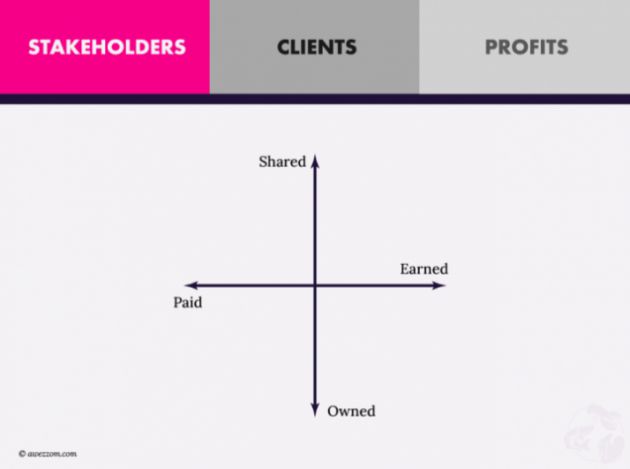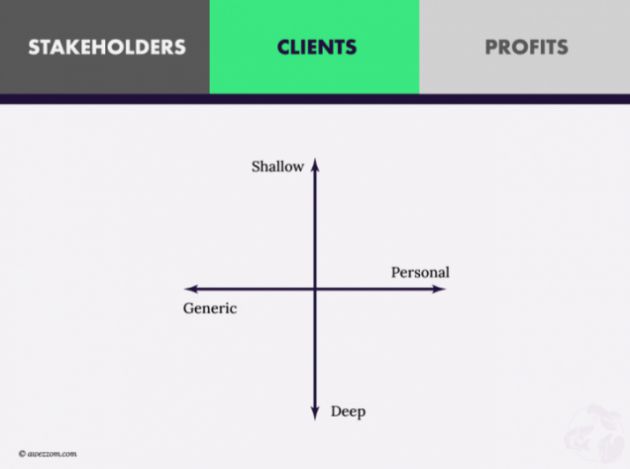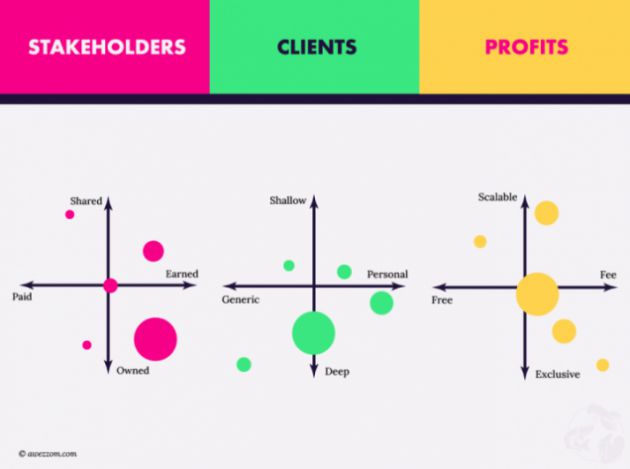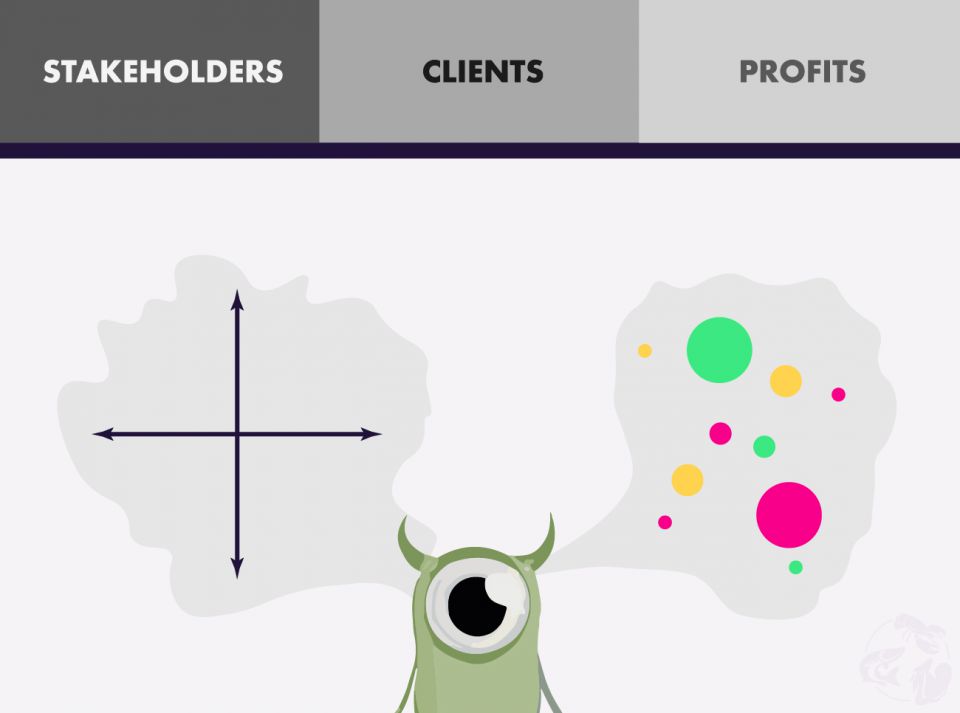Here is a thought that now and then crosses your mind (if you’re a managing partner, principal, marketing director). Prospects consent to having a conversation with your firm about your services, as well as reading, watching or listening to your content when they are interested. They are willing to hear you out when whatever you’re trying to communicate rings a bell. Thus your marketing communications should carry a message with a compelling idea you want to convey.
An idea without context rarely hits home. To successfully deliver our messages across we wrap content around ideas and go about delivering them to our target audiences via various marketing channels.
Content and its distribution channel(-s) are interconnected: one doesn’t make sense without another. The problem of course is that there are numerous ways of content creation and quite a number of channels. Given the limited amount of resources partners, principals and marketing officers have to make tough choices — what kind of content to focus on and where to disseminate it?
The obvious answer is — anything that generates more business works. However, the metrics on marketing comms with regard to professional services aren’t as straightforward as with goods — a flashy discount doesn’t result in an impulse purchase. It takes more time to sell a professional service (heavy discounters, actually, win less bids).
Buyers of professional services come across multiple marketing channels and engage with different types of content that provide information about the firm prior to engaging it: emails, website copy, industry articles, webinars, seminar recordings, social media posts, white papers, etc.
Singling out one type of content on one marketing channel that works best, and focusing on it, is improbable. Was it the last email that triggered the prospect or was it our thought leadership content on our website? Perhaps it was our recent book or perhaps a speech we gave at a conference? Or was it a forward from a mutual contact on LinkedIn — who knows? In my experience, it’s a combination of the above and not just a single piece of marketing communications.
On the one hand, we have endless idea-wrapping content opportunities with a plethora of communication channels. On the other, scarce resources: time, money, and people. Trying out every option to gather the data and distill the best combo isn’t feasible for most firms. All of this begs for a handy way of qualifying the looming content-related marketing decisions.
If only we had a map that would point to “the right” content and its distribution methods guiding us toward our main objective.
Three relationships to the purpose of the content
At this point I feel I must take a short detour to set the stage properly.
Content doesn’t come from (nor exists in) a vacuum. There is always a relationship between the content itself, an entity that commissions it, people who create it, people who distribute it, and people who derive value from it.
Marketing content typically serves a purpose. People who create content have a sense of purpose to this activity — the reason behind doing this and not something else. People who consume the content also have a purpose in so doing. In the business setting the ultimate purpose of going through the trouble (and expense) of making marketing content is to drive more business from the desired target audience.
Thus we can identify three types of relationships in regard to marketing content:
- stakeholder relationship — those who will benefit from interacting with the content;
- client relationship — target audience that is supposed to get value from it;
- profit relationship — our firm should get some kind of return on investment.
Now let’s get back to the main train of thought.
Maps of marketing content
If you accept that your firm’s primary objective is to make the business sustainable you might entertain the following idea. The perfect marketing content is the one that pays for itself, delivers value to the target audience and makes producers and distributors excited about having more.
If that’s the kind of content we want, we need three separate maps to help us navigate the three content-related terrains: Stakeholders (S), Clients (C) and Profit (P).
The map for Stakeholders terrain
In my search for the first map (S) I came across Gini Dietrich’s PESO model which sorts media into four categories: paid, earned, shared and owned. According to this model, we should start off by creating own content, share it through social media, pay to amplify the message and in time earn the privilege to appear on other communication channels.
The reason why I consider this model to describe the Stakeholders’ terrain is as follows:

- Our owned media channels will reflect the competence and enthusiasm of our employees who will create the content, and will transmit their attitudes through it.
- People on shared media will spread our message if it resonates with their personal beliefs and values.
- Paid media will publish (almost) whatever as long as we sign the check.
- Earned media will talk about us if they find it beneficial for them and their audiences.
These four points describe the benefits stakeholders expect from relationship with our content.
If the content we produce isn’t worth talking about, it won’t get into the earned media. If we don’t have enough money to boost it, it won’t pass the gatekeepers of the paid media. If the content is generic or bland, it isn’t worth sharing. If our employees aren’t excited about the new content they won’t put extra effort; and it always shows.
Not every piece of content we produce, by default, satisfies the anticipations of every stakeholder of the four media categories; not every type of marketing content fits every media channel. By focusing on the expected benefits of stakeholders at each of the four media categories we can map out the content we (should) want to produce.
However, as good as it is, the PESO model doesn’t address the other two aspects related to marketing content: clients and profit.
The map for Clients terrain
Clients pay for value. Buyers of professional services perceive value two-fold: the technical side of it and the non-technical experiential side. Thus whenever our target audience comes in contact with our marketing content we ought to meet their expectations of two-fold value.
The search for the second map (C) lead me to (re-)discover a Brand Experience map described in “The Brand Flip” by Marty Neumeier. The author offers a list of so-called touchpoints and suggests a way how to distribute them for a holistic brand experience on a “journey from awareness to commitment”. While some of these touchpoints (e.g., business cards, signage) aren’t content-driven media channels per se, many of them are (e.g., workshops, seminars, emails).

The two axes of this map run from Generic to Personal, and from Shallow to Deep. Here is why I consider this map to be descriptive of the Clients’ terrain.
The spectrum in-between Generic and Personal is a good descriptor of the non-technical experiential side of the value. An online ad is a good example of generic experience for our target audience. An in-person seminar for a handful of select individuals on the other hand can be very personal (thus very valuable) in its experience.
The axis from Shallow to Deep allows us to assess the technical side of the perceived value. For example, we can create a marketing email announcement (shallow); or we could spend three years writing an insightful book on a very specific subject matter and use it as a very deep marketing content-channel.
Thus the Generic, Personal, Shallow and Deep (GPSD — for the lack of my imagination) map describes the value our clients (prospects, leads, target audience) expect from the relationship with our content. Knowing this we can map out the required content-channels with holistic two-fold value experiences.
The map for Profit terrain
Alas, despite my attempts to find a good Profit-related map, I failed to discover one (yet). For the lack of a better one, here is a map I managed to come up with; whether it’s good-enough remains to be seen.

Marketing content creation and its distribution presumes expenditure of resources. Thus the relationship it has with the Profit terrain is, on the one hand, with how much it costs per unit of creation-distribution, and, on the other hand, with how much it sells for.
This brings us to two axes of the third map (P) : from Scalable to Exclusive and from Free to Fee. The following four points illustrate why I believe this map to be descriptive of the Profit terrain:
- Scalable content introduces the benefits of the economies of scale. Done well-enough once, we can then repackage, repurpose and repeat the same content on different media channels at minimal cost to the business.
- Exclusive content is usually the most expensive one to produce and cannot be duplicated, e.g., an annual live seminar with invitation-only limited capacity. The perceived value is in its scarcity, which carries a potential to offset the costs.
- Free content (like a benevolent bait) can attract potential buyers from a larger pool, help with establishing authority, put your firm on the map.
- A fee-based content is supposed to be valuable enough for its target audience to eagerly pay for it, thus partially covering production costs or even making the profit for your firm.
Understanding the relationship of content to Profit allows us to better evaluate our capacity and assess potential returns.
Putting three (S, C, P) maps together
Neither of the three maps suggest that the best content-channel for your firm is to be found at specific ends of the provided axes. It isn’t necessarily the case that Deep, Personal, Exclusive, Fee, Owned and Shared seminar, for example, is better than an expert book, which is Deep, Generic, Scalable, Fee, Owned and Earned. If it was — why write a book?
These maps invite you to plan your approach to marketing content in a holistic way, making sure you have different kinds of content-channels as they all contribute to the ultimate goal of making your firm sustainable.
However, for professional services firms that strive for a sweet spot in the marketplace there will be an expected tendency to develop more of Deep-Personal, Scalable-Fee, Owned-Earned content-channels.

These three maps fit well into the Swan-Crawfish-Pike (SCP) model that helps with qualifying business decisions at a sustainable professional services practice. To qualify your content-related decision, you’d place existing marketing efforts on the three maps and identify what content-channels are missing.
What do you think — would your firm benefit from navigating content-channel related challenges with these three maps?
The awezzom question of the day:
Given our limited resources how can we qualify our decisions in regard to marketing content production?

